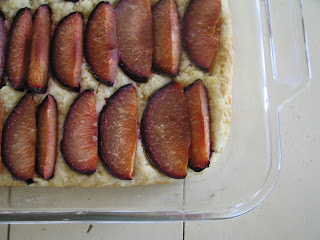
I'm a careful eater. I conscientiously eat yoghurt, sunflower seeds, and chopped fruit every morning for breakfast. When I cook for myself, I always steam my vegetables instead of cooking them with oil. I buy whole grain everything. I monitor my protein intake, and I eat things like raisins and prunes for snacks. Basically, I have a lot of annoying food habits, and it takes something really stressful to break my willpower.
When my willpower goes down, though, it usually follows three general paths:
1. Peanut butter
2. Chocolate
3. Any and all baking ingredients
(The only good thing about the above list is that no one ever steals from my peanut butter jar because - since my willpower does not break down along a "sliced bread" path - I eat PB directly off the spoon which I double, triple, quad..*ahem*..dip).
Why am I telling you this? Because these cookies totally stressed me out, and since, as I already mentioned, my broken willpower almost always manifests itself through intense sugar binges, the combination of stress and cookie really does not make for a pretty result. I mean, I ATE. As many chocolate chips as I could stuff in my mouth at once. Chunks of marzipan. Toasted almonds, yes, want! Where's the spatula so I can scrape the bowl? Why not also scrape the melted chocolate? Lick the spatula!
I made a million critical errors during the production of these cookies. For example, when I'm altering a recipe that I plan to blog, measure the flour! Also I ruined the chocolate chips that I melted in the microwave - how is that even possible? I decided, even though I knew that the cookies had a high sugar content and no butter, that I wouldn't grease the baking sheet. Fail! Stick! Spilled almonds, yes; almonds that fell off the cookies, of course, and no, fake Ziploc really doesn't work well for piping melted chocolate. Instead, it leads to chocolate blobs all over your face, table, and chair.
I should have taken a picture for you, but unfortunately that was impossible because my fingers were covered in my melted chocolate failure, and my palms were full of dough that I was stuffing in my face.
(Hang on - peanut butter run - just writing this is stressing me out! Let me just stick that spoon into the dishwasher. . .)
But wait, don't go run for you peanut butter jars just yet! (What's that? You don't binge on PB? Because you really should). I have conveniently fixed up this recipe so that you avoid all of my silly mistakes! More importantly, these cookies were heavenly. I just ate the last one. Mmm, mmm, mmm.
Almond Crescents
makes about 4 dozen
Ingredients
-500 grams marzipan (check the package for the weight)
-1 1/3 cups sugar
-1 pinch salt
-3 egg whites
-1 cup flour
-1 cup sliced almonds, coarsely chopped
-butter or shortening for greasing your baking sheet
-3/4 cup semisweet chocolate chips
Method
Preheat your oven to 350 degrees. Thoroughly butter a cookie sheet.
In a medium bowl or in the bowl of your standing mixer, mix together the marzipan, sugar, salt, and egg whites until the ingredients are thoroughly combined and the dough is soft. Then slowly add the flour a tablespoon at a time. The dough will still be sticky, just less so, at the end.
Then you'll need to shape the cookies. To do this use either piping tools - a heavy pastry bag and a 1/2-in-wide piping tube - or else a heavy duty Ziploc bag with a 1/2-in-wide whole cut in one corner. Fold over the top of the bag, and put a large scoop of dough inside. You don't want to overload the bag because it could burst or squirt out the top, but you also need enough dough to create enough tension to be able to pipe at all. Unfold the bag, and twist the top tightly. Pipe crescent-shaped snakes of dough that are about 2 1/2 inches long, spacing them 1 inch apart on a cookie sheet. Check the above picture to see what the unbaked dough snakes should look like.
Now pour your coarsely chopped almonds into a bowl, and, using your fingers, press almond chunks into the tops of the cookies. Make sure they are firmly embedded into the dough or else they may fall off. Bake the cookies for 12 to 17 minutes until they are lightly browned. After I severely underbaked the first dozen, my cookies took about 16 minutes to finish.
Once the cookies have baked, remove them from the oven, and let them cool about 75%. Then transfer them to a wire wrack or another surface to cool completely. You'll be adding chocolate to the tops next so it may be helpful to put your cookies in the fridge until just before you add chocolate.
In order to decorate the tops with chocolate, melt the chocolate chips in the microwave, and give them a stir. You can then either dips the ends of the cookies into the chocolate or you can use the tines of a fork or the end of a spoon to drizzle threads of chocolate over the tops of the crescents. I opted for method two, and, post-chocolate explosion, my cookies turned out beautifully. Return your cookies to the fridge to cool for at least 1/2 hour before serving.
Excellent with tea, coffee, or ice cream.

















